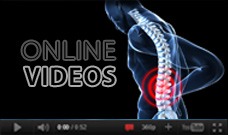Scheuermann's Kyphosis
Scheuermann’s kyphosis causes hunch back in adolescents. Scheuermann’s kyphosis is not caused by poor posture but occurs due to an increased curvature of the thoracic spine. It is more common in adolescent boys than girls.
Causes
The exact cause of Scheuermann’s kyphosis is still not clear. A spinal X-ray of patients with Scheuermann’s kyphosis shows characteristic wedge shaped vertebrae and schmorl’s nodes. It has been believed that the abnormal development of these wedge shaped vertebrae during the adolescent growth phase is responsible for the increased curvature of the thoracic spine. Moreover these patients also have a weak vertebral end plate, separating the vertebrae from the cartilaginous intervertebral disc, as a result of which the contents of the intervertebral disc can squeeze through the endplate into the vertebral bodies forming schmorl’s nodes.
Genetics play an important role in development of Scheuermann’s kyphosis as it is more common in individuals with a positive family history.
Symptoms
The hunch back is a cause of mild back pain. The other symptoms of Scheuermann’s kyphosis include fatigue, stiffness and tenderness of the spine. In severe cases the abnormal curvature may exert extra pressure on the lungs leading to breathing difficulties.
Diagnosis
The diagnosis of Scheuermann’s kyphosis includes:
Family history: Incidence is more common in individuals with a positive family history.
Medical history: Medical history represents the present health of the patient and helps the physician in devising an individualized approach for the diagnosis as well as treatment of the condition.
Physical examination: The physical examination of a patient with Scheuermann’s kyphosis includes palpation and evaluation of range of motion and stability of the spine. Adam’s forward bending test is also performed in which the patient is asked to bend forward at the waist with the arms extended forward while the doctor evaluates the hunch back and the prominence of the ribs and shoulder blades.
Neurological examination: Neurological examination is performed to identify signs of neurological injury, muscle weakness, numbness and abnormal reflexes.
Imaging studies: Several X-rays of the spine in different positions are performed to observe the spinal changes. Other imaging tests such as CT or MRI scans may also be conducted. A MRI is usually performed to assess for nerve compression due to bending.
Other specific tests for Scheuermann’s kyphosis may include measurement of the degree of the abnormal spinal curvature, skeletal maturity and the rate of progression of Scheuermann’s kyphosis.
Criteria for the diagnosis of Scheuermann’s kyphosis include:
- Kyphotic curve equal to or greater than 50 degrees
- At least three or more adjacent vertebrae with an anterior wedging of 5 degrees or more
- X-ray reveals presence of schmorl’s nodes
Treatment
Treatment of Scheuermann’s kyphosis usually involves spinal bracing and physical therapy. Spinal bracing prevents progression of the condition while physical therapy helps in improving the flexibility and strength of the spine. The patient is advised on regular checkups to monitor the progression of the curve.
Surgery is recommended only in severe cases with either a curvature beyond 70 degrees, or the presence of severe pain, neurologic dysfunction or difficulty in breathing. Surgery involves fusion and spinal instrumentation aimed at rectifying the deformity, preventing the progression of the curve and stabilizing the spine. An open or minimally invasive approach can be used for surgery. A spinal brace may be recommended after the surgery. Periodic X-rays are conducted, after the surgery, to monitor proper bone fusion and healing.
Consult your surgeon in case you have any queries about Scheuermann’s kyphosis. |











